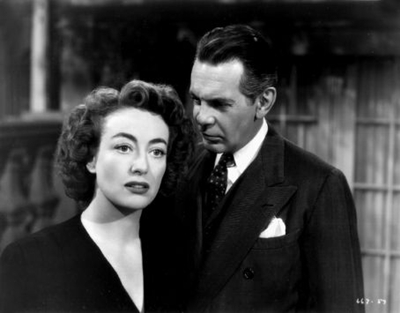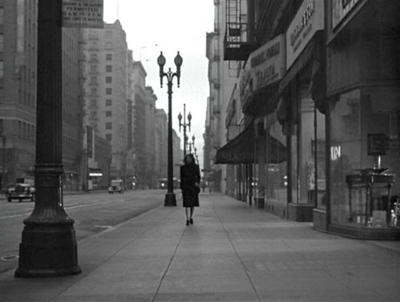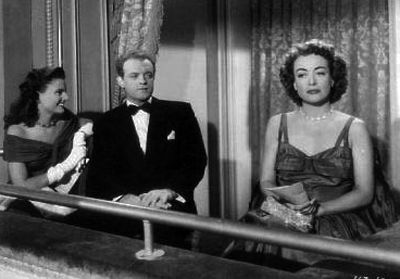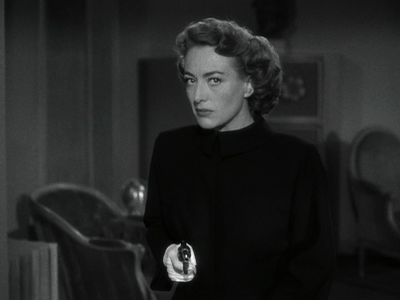‘Possessed’ will play at the Arthur Lyons Film Noir Festival in Palm Springs, which starts on Thursday, May 10, and runs through the weekend.
Possessed/ 1947/Warner Bros. Pictures/108 min.
WWJD? What Would Joan Do is an acronym I use to remind myself that in times of trial, or just dreary old doubt, I can always conjure some outrageous guidance in the spirit of the indomitable Miss Joan Crawford.
“You see?” Joan would purr in her low, silky voice, were she still alive. “It sounds severe, but it’s really rather effective.”
Work woes? If you’ve patiently kept your nose to the grindstone and still haven’t received a promotion, it might be time to march into the boardroom and shout: “Don’t mess with me, fellas!”
Slovenly roommate? Never underestimate the effect of throwing a few hangers around to drive home the point that the apartment is not likely to start cleaning itself.
Man trouble? A quick jab with your stiletto to his foot or chin every 10 minutes or so should ensure that the rapscallion not only listens but also hangs on your every word over dinner.
Admittedly, actually doing any of the above or generally taking cues from the Queen of the Ankle-Strap Shoe would likely lead to disastrous results. But the point is that imagining WWJD is nearly as entertaining as watching the many movies in which she played tough strong women who made up their minds to go after what they wanted. And. Didn’t. Stop. Until. They. Got. It.
Getting what she wants is certainly central to her character in director Curtis Bernhardt’s “Possessed” from 1947. Joan plays Louise Howell Graham, a determined gal who doesn’t take it very well when her boyfriend David Sutton (Van Heflin) dumps her. Louise is convinced that if she tries hard enough, David will come to his senses and realize that he does love her, after all.
She even marries wealthy widower Dean Graham (Raymond Massey) as a ploy to win David back. (Need I say the ploy doesn’t work?) When Louise’s stepdaughter Carol (Geraldine Brooks) also falls for David, things get sticky. Or perhaps shaky is a better word because Louise goes off the deep end into a full-fledged psychotic state, though when she eventually pulls the trigger of a gun, her hand is rock steady.
You realize in the opening scene that Louise is in La La Land, literally and figuratively, as she wanders the streets of LA calling David’s name. In a drab dress, hideous shoes, no lipstick and her hair a mess? She needs new medication or an emergency shopping trip to Rodeo Drive. Someone help this woman, please! And mercifully someone does. Louise’s story comes to us in flashback as she tells her doctors in the hospital psycho ward.
The movie is director Bernhardt’s exploration of an unhinged mind. A German Jew well-schooled in the tenets of Expressionism, his visual techniques to show us Louise’s inner torment include high-contrast light and shadow as well as stunningly extreme camera angles to create a sense of emotional chaos.

Steady and wealthy husband Dean Graham (Raymond Massey) adores Louise and, more importantly, believes her lies.
Crowded, asymmetric compositions reveal her sense of entrapment and imbalance. Particularly famous, and beautifully lit, is Louise’s disaster-fantasy scene where she confronts Carol near a flight of stairs – essentially a distorted dream sequence that reflects Louise’s anguish. Joseph Valentine and Sidney Hickox (uncredited) were the cinematographers.
A sweeping score by Franz Waxman highlights Louise’s subjective point of view, particularly her splintered personality. (On the DVD release, film historian Drew Casper offers an informative, if gushy, commentary that details Bernhardt’s methods.)
The intense script came from Ranald MacDougall, Silvia Richards and Lawrence Menkin; it was based on a Rita Weiman story. MacDougall was a favorite of Joan’s. He was the lead writer of “Mildred Pierce” (1945, Michael Curtiz) based on James M. Cain’s novel. MacDougall also adapted and directed 1955’s “Queen Bee.”
It’s Joan’s movie, to be sure, but there’s a terrific chemistry among these well cast players. Heflin plays a douche bag like no other, Massey fairly radiates standup sincerity and goodness, and Brooks shines as his sweet and sexy daughter.
By today’s standards, Joan’s acting is a little over the top, but it’s hard to think of another actress who could’ve pulled off this part (it’s a crazy lady, after all) any better. As James Agee sagely noted, “Miss Crawford performs with the passion and intelligence of an actress who is not content with just one Oscar.”
Her performance in “Possessed” was nominated for a best-actress Oscar but, having won for “Mildred Pierce,” her chances were slim; she lost to Loretta Young in “The Farmer’s Daughter.” (She was also nominated for “Sudden Fear,” from 1952, but the award went to Shirley Booth in “Come Back, Little Sheba.”)
The genius of Joan is that she while she might’ve overplayed it a tad, she always retained a sense of dignity and backbone that made you admire her a little, even if she was nuts. My favorite scene is when hubby Dean asks her why she lied to him. She answers, in a blasé tone, “Because I felt like it. I wanted to lie and I lied. Let me alone.”
This reminds me of a story my mother told me once. She and her best friend, both newly married, attended a bridal shower where the guests were asked to write down a piece of advice for a happy marriage. The two of them suggested the following: “Tell one lie every day.” When it came time to read each item aloud, the other guests were aghast at this exhortation to fib. Still, my mother and her friend got quite a good chuckle out of it.
I think Joan would have too.













From FNB readers